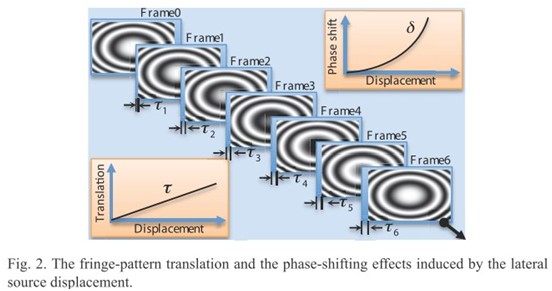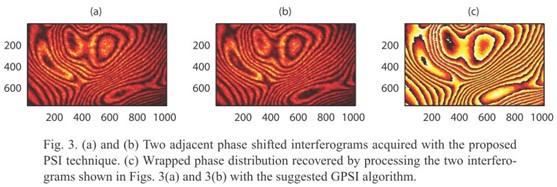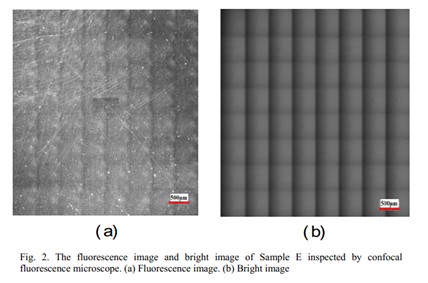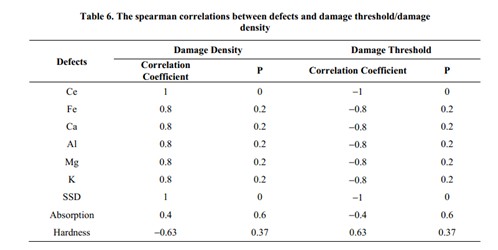doi: 10.1364/OE.21.017228
published:2013.07.11
内容介绍:
Carlos Robledo-Sanchez等提出了一种简单、低成本的光学装置来实现相移干涉。这一光学装置以泰曼-格林干涉仪为基础,而其相移则是由激光点光源的横向位移引入。文章从理论上解释了这一方法引入的位相改变,其实验结果也与理论预期保持一致。另外,通过利用两幅或更多幅的任意且未知相移量的干涉图所生成的相移算法,恢复出了相移和位相包络。实验和理论结果说明了这一相移技术的可行性。
与需要高精度纳米位移的传统PZT相移技术不同,在文章提出的这一新颖相移技术中,一个带有测微螺杆的粗调整甚至未精确校准的实验台就足够了,相移灵敏度则通过干涉仪中反射镜之间的光程差来调整。利用文中介绍的GPSI位相解调算法,诸如二次相移、校准误差及其他未知的可能误差都可以被消除。



doi:10.1364/OE.21.012204
published:2013.05.10
内容介绍:
在融石英光学元件亚表面层,有很多种类的亚表面缺陷。仅仅研究一种缺陷对激光损伤的影响是不科学的。因此,需要从综合化的视角研究亚表面缺陷对激光诱发损伤的影响。本文通过飞行时间次级离子质谱法(TOF-SIMS),荧光显微技术,光热共路干涉仪和全自动微观硬度探测仪对污渍、亚表面疵病、光热吸收和融石英光学元件表面硬度进行分类。并采用351nm的纳秒脉冲激光器测量激光诱发损伤阈值和损伤密度。
结果表明,亚表面损伤和Ce元素对损伤阈值和损伤密度有很强的影响。Ce元素对损伤阈值有很大的影响,亚表面疵病密度强烈影响损伤密度。其他的金属杂质、硬度、光热吸收对损伤的表现影响微弱。


doi: 10.1038/nphoton.2013.171
published:2013.07.14
Abstract:
All limitations commonly associated with imaging, such as resolution, field of view and depth of field, arise from linear theory. Nonlinear optics can break these limits by exploiting the presence and interaction of many photons at once. To date, nearly all nonlinear imaging techniques have relied on point processes, such as two-photon fluorescence or harmonic effects, in which the temporal frequency is the relevant parameter. These methods ignore the spatial content of the object, typically require scanning to record a whole image, and remain restricted by linear propagation from the sample to the detector. Spatial nonlinearity can overcome these issues by mixing modes with high and low spatial frequencies. Here, we generalize Abbe's theory of diffraction to include nonlinear propagation and show that wave mixing can be treated as a self-induced structured illumination. We demonstrate this experimentally by nonlinearly enhancing a standard imaging system beyond its conventional limits.
doi: 10.1364/OL.38.002550
published:2013.07.15
Abstract:
This Letter analyzes the imaging performance of Bessel beam microscopy (BBM), an imaging technique that places an axicon in the light path of a microscope. Like other superresolution imaging techniques that attempt to narrow the point spread function, in BBM there is a trade-off between spatial resolution and relative brightness of the images. The performance of BBM is analyzed using two parameters, gain and Strehl ratio, which measure the relative spatial resolution increase and relative brightness of the images, respectively. Analytical relationships for both of these parameters are provided and compared to results calculated from simulations. Finally, an optimized BBM system design is presented which has a gain of 0.7 and a Strehl ratio of 0.9.
doi:10.1364/OL.38.002711
published:2013.08.01
Abstract:
In this Letter, multifocus optical-resolution photoacoustic microscopy is demonstrated using wavelength tuning and chromatic aberration for depth scanning. Discrete focal zones at several depth locations were created by refocusing light from a polarization-maintaining single-mode fiber pumped by a nanosecond fiber laser. The fiber and laser parameters were chosen to take advantage of stimulated Raman scattering (SRS) in the fiber to create a multiwavelength output that could then be bandpass filtered. The collimator lens and objective lens are chosen to take advantage of chromatic aberration in which each generated SRS wavelength peak focuses at a slightly different depth. The maximum amplitude of photoacoustic signals is mapped to form C-scan images. Additionally, all wavelength peaks fired simultaneously offers improved depth-of-field structural imaging at the cost of slight degradation of mainlobe-to-sidelobe ratios. Wavelength-tuned depth scanning over more than 440 μm is demonstrated, significantly greater than the ∼100 μmdepth of field predicted from our focused Gaussian beams. The improved depth of focus could be valuable for structural imaging of microvascular morphology without the need for mechanical scanning in the depth direction.
doi:10.1038/nphoton.2013.151
published:2013.07.07
Abstract:
Ultrafast studies1, 2 of excitations on the nanometre scale are essential for guiding applications in nanotechnology. Efforts to integrate femtosecond lasers with scanning tunnelling microscopes (STMs)3 have yielded a number of ultrafast STM techniques4, 5, 6, 7, 8, 9, 10, 11, 12, 13, 14, but the basic ability to directly modulate the STM junction bias while maintaining nanometre spatial resolution has been limited to ~10 ps (refs 7,8) and has required specialized probe or sample structures. Here, without any modification to the STM design, we modulate the STM junction bias by coupling terahertz pulses to the scanning probe tip of an STM and demonstrate terahertz-pulse-induced tunnelling in an STM. The terahertz STM (THz-STM) provides simultaneous subpicosecond (<500 fs) time resolution and nanometre (2 nm) imaging resolution under ambient laboratory conditions, and can directly image ultrafast carrier capture into a single InAs nanodot. The THz-STM accesses an ultrafast tunnelling regime that opens the door to subpicosecond scanning probe microscopy of materials with atomic resolution.







